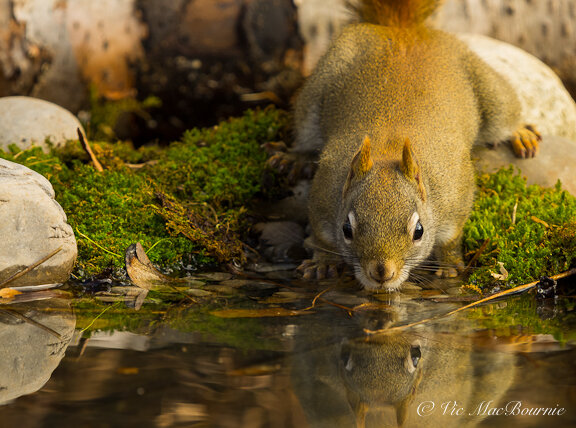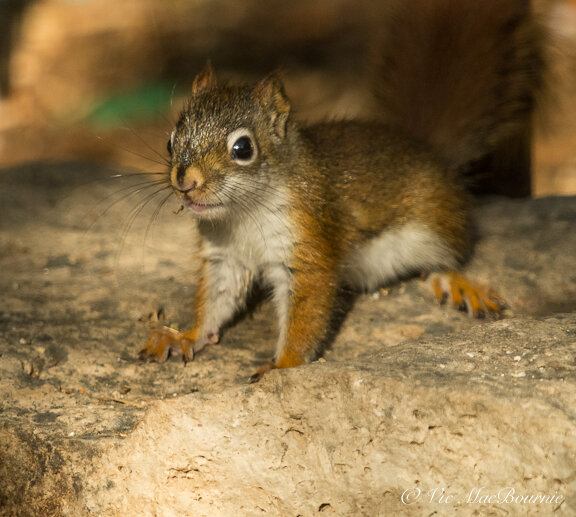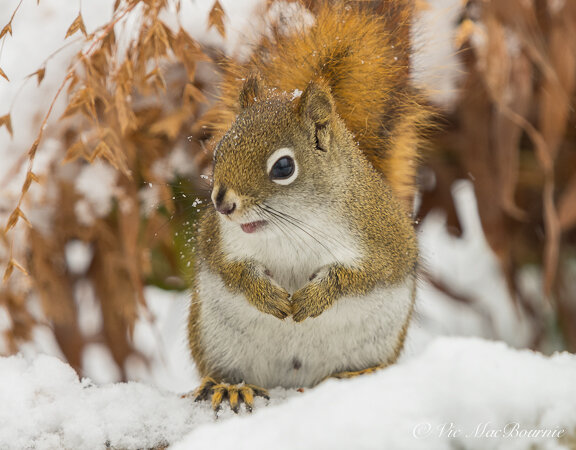Living with and attracting friendly little red squirrels
Red squirrels, oak trees and acorns in our woodland garden
One look at the little red squirrel and I couldn’t help falling in love.
She could not have been very old and yet was brave enough to hang out under the feeder with the big boys: Big bruising American grey squirrels (some jet black and three times larger than her), mature red squirrels, and a host of very aggressive little chipmunks.
But she held her own, keeping a safe distance from the others while she scrounged what sunflower seeds and other tidbits she could find under the bird feeders.
I’m sure mom wasn’t far away keeping an eye out for her babies. During March and April, females have litters of between three to seven babies.
If you are looking to attract the American Red Squirrel to your woodland garden, be sure to include their favourite food sources, Oaks for their prized acorns, pine trees for their seeds, native berries and flowers for their seeds (Black Eyed Susans and Purple Coneflowers are good choices). These tree squirrel also appreciate a good sized woodpile where they can hide their stash for the winter.
Technically, this little red squirrel was actually what we call an American Red Squirrel, not to be mistaken by the even cuter and much more timid Eurasian Red Squirrel.
A digital digital painting of one of our cute little red squirrels.
The British counterpart (Eurasian Red Squirrel), complete with its adorable tufted ears, is actually becoming a threatened species in most parts of Europe because of its more timid, non-territorial stand against the introduced American Grey squirrel, which are all too familiar in backyards across the United States and Canada. The Grey squirrels were introduced to Great Britain in the 1800s resulting in the slow decline of the red squirrels. It is estimated that at one time red squirrels numbered in the 3 million. That number is now at about 120,000.
Dani Conner’s baby red squirrels video
For more on the Eurasion Red squirrel, be sure to check out Dani Connor and her entertaining You Tube channel about the Eurasian Red Squirrel. Dani is a talented wildlife photographer and Zoologist originally from London, UK who is now living in Sweden.
Recently she became mom to four orphaned baby red squirrels and has spent a lot of time with them gaining their trust. The kits allowed her to photograph them and record the sound they make when they eat, which went viral on Twitter gaining 14.8 million views.
Her YouTube videos are well worth watching and she has a Patreon site you may want to investigate.
American Red Squirrel at reflection pond.
If you are lucky enough to have American red squirrels in your backyard, you’ll know why the grey squirrels won’t be forcing them out any time soon. When it comes to who gets fed first around our feeders, the red squirrels make it clear up front that they’re not about to back down to the much larger greys.
Besides their willingness to communicate (the American red squirrel can often be heard communicating with a lengthy, descending trill and a persistent chatter of assorted notes and chucks), they are not afraid to show their annoyance with competitors around a food source.
In our yard their vocalizations are also one of the early warning signs that an intruder is about – especially one of the neighbourhood foxes. The Red Squirrels carry on for quite some time warning others of the dangers – including a hawk or own if they see it first.
I’ve seen one red squirrel chase a much larger grey squirrel from one end of the yard to the other when the grey squirrel intruded on its dinner party. I think it’s as much a game as it is a show of strength because they all more or less get along under the feeder. The real aggression is more likely between two reds than a red and a grey.
It can be great fun watching these little guys from inside the photographic blind. I’m sure they know I’m there, but they eventually become oblivious to me and the blind. In fact, I’ve had them jump on the blind while I’m inside mistaking the camouflage for a real tree or bush.
An immature American Red Squirrel looking for scraps of food under the bird feeder, always on the watch for predators and other feisty fellow. How can you not fall in love with this little fella?
On another occasion one Red squirrel chased another right through the blind when I was sitting in it. In one side and out the other before I even knew I had a couple of visitors.
Red squirrels can be feisty and territorial toward intruders, especially when food is involved. A showdown between two red squirrels is sure to involve plenty of tail flicking, chattering and even foot stomping. Trust me, it may look like they are having fun, but the argument can get pretty heated at times.
That tail of theirs can measure about half the size of the squirrel and when they are not using it to assert their dominance, its primarily used for balance as the squirrel moves from tree to tree in the woodland garden.
A lovely little Red Squirrel poses on a branch as it enjoys a snack.
Are red squirrels friendly?
I’ll never forget the time I was feeding one of our red squirrels peanuts and photographing her in our front garden, when she got around behind me and jumped up on my shoulder. Now that was an experience I’ll not forget.
She didn’t stay long and after a quick sniff she jumped down onto a rock to continue scoring peanuts from me.
Although they are territorial around other red squirrels, these little fellas are quite friendly and can be trained to take peanuts right out of your hand.
Unlike our chipmunks, I tend to just toss them their treats rather than have them take the peanuts directly from my hand. (See my article on how to hand feed chipmunks.)
Are American Red Squirrels a threatened species
The American Red squirrels’ aggressive/territorial approach to guarding food helps keep our red squirrel numbers healthy and might account for our baby red squirrel holding her own in the face of a host of other, much larger squirrels around her.
Although red squirrels can be rare in some areas, including urban areas, their numbers are not under threat in North America. Unlike the Eurasian reds, whose numbers have fallen dramatically and efforts are having to be made to protect the remaining populations.
You may also have Fox squirrels living or visiting your bird feeders. It is typically found in the eastern United States and Canada. Not unlike the smaller American Red Squirrel, the Fox squirrels have a lot of red in their coats, but they are actually much larger. In fact, they are the largest tree squirrel in North America weighing up to two pounds compared to the much smaller Red Squirrels that weigh in at an average half pound.
American Red Squirrels do not hibernate. Instead they store large caches of food in what is called a midden.
According to the extremely informative website Squirrels At the Feeder, the main difference between the American and Eurasia Red Squirrels can be seen in how they store food for the winter. Both of these species stash away food for winter months as neither species hibernates. The Eurasian Red Squirrel scatters the food caches in multiple locations throughout the forest. The American Red Squirrel creates a massive central stash called a midden which it defends with its life.”
What do the American Red Squirrels eat
Since our red squirrels don’t hibernate during the winter, they are extremely busy in the fall collecting food for the upcoming cold months.
Red squirrels, by definition are omnivores, and their diet may surprise readers. Their primary diet consists mainly of the seeds and cones of evergreen trees as well as nuts and, especially acorns. Their diets, however, actually extend to include native flowers, a variety of berries, mushrooms, bugs, eggs, small birds and even mice. Yes, red squirrels can help you control the mice population around your home.
Where do Red squirrels store their food?
Our red squirrels use tree cavities, brush piles and dens as their own food pantries where they can keep them safe from other foragers. (For my earlier article on building a brush pile go here.)
Around my home, they are regular visitors to the area under the bird feeders where they gather sunflower seeds and other droppings from the feeders. Unsalted peanuts (either shelled or unshelled) are a favourite treat that I like to offer them.
Where do they live?
The American Red Squirrel prefers coniferous forests and are particularly fond of pine forests but they will also inhabit deciduous woodland and are found in woodlands in suburban and near-urban areas throughout their range.
Their range is considered wide, stretching throughout the United States from the Alaskan forests through the Rocky Mountains in Canada to about Georgia.
Can Red Squirrels be problematic?
Like any rodent, red squirrels can become an annoyance if they get into the attic or other area where they do not belong. Their winter caches of food are a dead giveaway that they have moved in.
It’s always wise to use wildlife-friendly professionals to safely remove any rodents that find their way into your home.
Be sure to seal off any areas around the home to ensure there are no areas of easy access to your attic and you can enjoy these friendly little squirrels in the natural areas of your yard where they belong.





